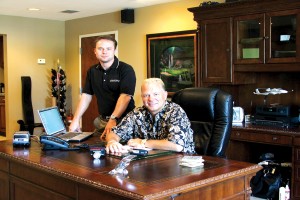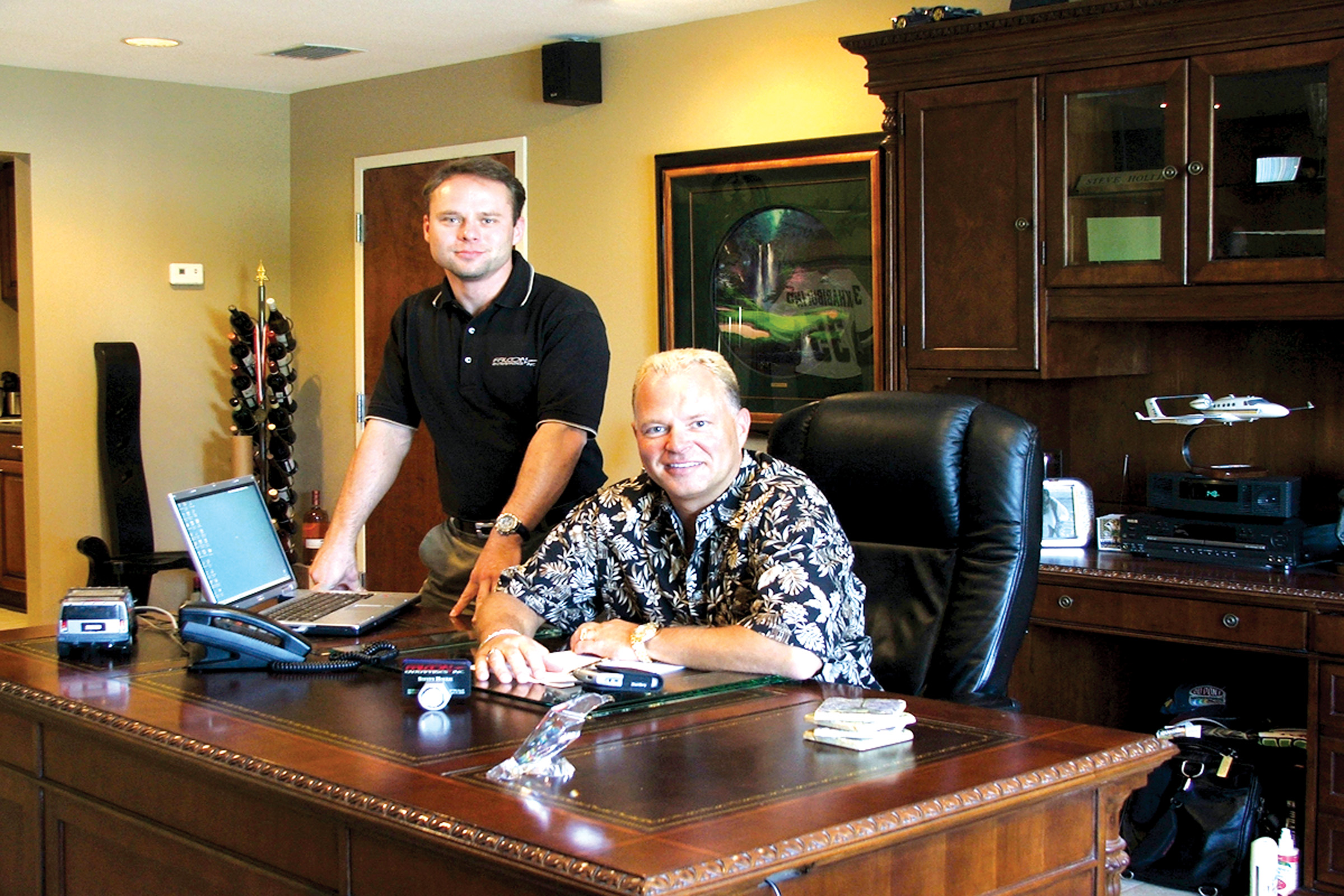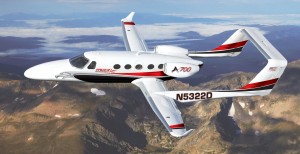By Jeff Mattoon

L to R: Pilot Mark Ertel and Steve Holtje take a moment from a busy day. Notice the A700 model to the right.
For 22 years, Steve Holtje has owned his own business; while that may not seem like a big deal, considering he’s only 47, business success has followed him nearly half his life. That’s a good thing, because according to his wife Christine, he really loves toys—big toys.
It all started when Holtje and his brother Phil decided to follow in their parents’ footsteps to work in the printing and graphics business. After he graduated from Trinity College in Deerfield, Ill., with a business degree, Holtje moved back to his hometown of Racine, Wis., to join the sales staff of the business owned by family friends.
Things looked good. Phil Holtje was vice president of manufacturing; they were sure they’d be given a shot at buying the company sometime in the future. That is until the five partners decided to sell, leaving Steve Holtje’s future ownership in the cold.
It didn’t take long for the two brothers to launch their own venture. In 1983, they started another printing and graphics company, but eventually Steve Holtje became restless, wanting to move his portion of the company where the sun shines a little more often. With great frustration, he set up shop near St. Petersburg, Fla. The difficult decision was worth it.
“It was tough splitting up the company, and in some ways it was much like a divorce,” he said. “It was financially devastating, but it worked out.”
Indeed it did. Falcon Enterprises, Inc. of Pinellas Park, Fla., is now the largest supplier of screen printing and graphic design to the marine and RV industry. Company sales were up 51 percent last year and are already up about 30 percent this year. If Holtje has his way, Falcon will soon be the largest supplier of graphics to the aviation industry.
“The Lear was not for us…”
The latter goal is the by-product of a fast-growing business. With most of their accounts in Southeast Texas, and with a second facility location in Elkhart, Ind., Holtje and his key sales and artistic staff chalked up thousands of miles commercially. A pilot acquaintance knew of their heavy travel schedules and made Holtje aware of a used Lear for sale.
“The Lear wasn’t the answer for us, but it got us thinking about an aircraft for the company,” he said. “We have very large accounts and many of them aren’t in easily reached areas of the country, so having a company plane began to make more and more sense.”
So many companies that purchase aircraft go about the process by selecting the aircraft and then looking for a pilot, but not Holtje and the management at Falcon. They sought a pilot first and commissioned him to find them the right airplane.
Mark Ertel got the nod and within a short time presented the Piper Meridian as the right aircraft for the company’s mission. In September of last year they took possession of a low-hour 2001 Meridian.
No direct profit
At first, Holtje’s wife Christine wasn’t sure it was such a good idea.
“I was raised by a single mother who’s an accountant, so I look at it as an expense because there’s no direct profit that comes from it,” she said. “However, there are intangibles. Before we got the plane, it seemed that Steve and I were doomed as far as travel goes. There seemed to always be a delay with security or the weather or some mechanical problem, so it’s much better with our own plane.”
Holtje said they were amazed at how much they used it.
“The plane made it so much easier to service our accounts and very quickly it was in the air one, maybe two times a week,” he said. “It’s a time machine for us. Trips that used to take two days are replaced by ones that allow us to be home by dinner.”
Holtje recounts a trip that was the rule for myriad accounts. Needing to meet with a client in the northwest section of Alabama, they would leave on Sunday afternoon for a Monday morning meeting. Arriving in Birmingham, they drove two and a half hours to a hotel, and then another half-hour in the morning to get to the meeting location.
The return flight gave them only two options: a morning flight, which obviously wouldn’t work, or a departing flight at 7:30 p.m., putting them back in St. Petersburg at 11:00 p.m. It would be a long couple of days, with over five hours driving time.
“Today, I can put an hour in at the plant on Monday,” says Holtje. “I’m an hour and 45 minutes from wheels up. We make our business call and when we’re done at three or four o’clock, we make a short drive to the plane and I’m back home for dinner. The plane has become a great asset.”
A month before getting the Meridian, Holtje’s art director had to make a trip to visit a Yamaha plant in Tennessee. Yamaha is a very demanding but very important account for Falcon, so when they called at 6:30 p.m. on a Tuesday for a Thursday meeting, Holtje booked the flight, costing the company $680, and taking the art director 11 hours on the return portion of the trip.
Continuing to fly commercially, Holtje would have been forced to add managers to fill the labor gap in the field and at the shop, but with a company-owned, quick airplane, trips like that take a fraction of the time and allow key personnel to perform their duties where needed.
None of this is new to those who use aircraft for business. Aircraft use and time savings have been around for decades. What is new is the type (or speed) of aircraft available to small businesses. Holtje and the managers at Falcon Enterprises are so impressed with the benefits of the Meridian that they, with the help of Ertel, are looking to a very light jet to provide more speed, giving clients even more value-added service.
“We love the Meridian and it’s great with two people, but when we’re flying three or four people, then it significantly reduces the amount of fuel we can carry, reducing our range,” comments Holtje.
Let’s get a VLJ
Ertel got busy requesting brochures and calling for specs. The answer for the Falcon Enterprises arose quickly—the Adam A700.
“The Eclipse was just too small in the cabin for our needs and the issue with the Mustang was delivery (Q4, 2008),” comments Holtje. “We became so excited about VLJs that we didn’t want to wait that long, but with the Adam A700, we could get delivery as early as the first quarter of 2007. That’s assuming all goes well with type certification.”
Within four months of taking delivery on their Piper Meridian, Falcon Enterprises placed an order for an Adam A700, a six-place, twin-turbofan VLJ.
The A700 at first glance doesn’t look like all the other proposed VLJs. Wings-forward it looks like a typical small aircraft, but aft of the wings, it’s a whole other story. Replacing the traditional empennage are twin-booms jutting back from the wings ending in two vertical stabilizers connected by a high horizontal elevator. Comments about its appearance have ranged from “It looks like a WWII-era flyer” to “It looks like a sleek, futuristic aircraft.” Beauty is definitely in the eye of the beholder.
Much has been written about Adam Aircraft, headquartered at Centennial Airport and headed by founder and CEO Rick Adam, whose background is in finance and software. In the early 1990s, when getting his pilot’s license, Adam was perplexed that there weren’t many choices in small modern aircraft. It seemed to him that with all the glitzy gadgets to choose from with automobiles, computers and electronics, general aviation had some catching up to do. He set out to offer his remedy.
By the end of the decade, he had formed Adam Aircraft to produce a new-style small general aviation plane that would offer performance, safety and efficiency through high technology. He recruited the aid of Burt Rutan to create a proof-of-concept resulting in an airframe that closely resembles today’s Adam airframe.
The first airplane Adam had built, which recently received type certification, was the A500, a twin-engine, in-line propeller offering centerline thrust with little or no adverse yaw on single-engine failure. The airframe is constructed of carbon composite materials, which give strength with lightweight characteristics.
Adam Aircraft is also working diligently to certify the new A700, the jet-engine fraternal twin of the A500. The A700 will stretch 30 inches longer in the fuselage allowing for an aft lavatory—a first and only in the VLJ category—and offer 25 more cubic feet of storage in the nose, which according to Joe Walker, company president, is enough to stow four sets of golf clubs.
The A700 was unveiled at Oshkosh in 2003 and now has over 300 hours in the air. According to Walker, 60 percent of its parts are certified. A third of the 240 reports required by the FAA will be completely new, another third will be modified by about 50 percent and the rest will completely transfer to the A700, allowing the jet twin to race on the fast track to certification. The current type certification target date is the second quarter of 2006.
Guaranteed insurability
A unique approach taken by Adam regarding insurance for the owner/operator is the guaranteed insurability program. Under the program, Adam will guarantee a pilot’s insurability if they will do a few things. First, purchase and fly an A500 for 200 hours, and secondly, have a combined 1,000 total flying hours. When those conditions are met, Adam guarantees your insurability or the deposit will be refunded.
“This has been a successful program for us,” says Walker. “Jumping from a single to a twin A500 is an easy step (because of centerline thrust). Jumping from an A500 to an A700 after 200 hours is also an easy step, and there’s a good argument that it might even be easier to fly the A700, because you’re going from six engine controls to two.”
Currently the A700 sells for $2.1 million with an initial down of $125,000 required. Another $125,000 is due upon certification and six months prior to delivery, another $125,000 is due. Why the heavy deposit requirements? According to Walker, it’s to create a quality customer backlog.
“Based on experience, if you ask for a very, very small amount on the front end, you’ll get speculators and you’ll have a high turn rate in your backlog,” suggests Walker.
There’s no doubt that Adam Aircraft is looking for the quality customer, not just quantity. Currently there are 50 owner/operator orders along with orders from air-taxi services including the much-ballyhooed order of 75 A700s from POGO Air.
With competitor Eclipse Aviation forging ahead toward certification of their aluminum Eclipse 500 VLJ, and with a reported 2,000-plus orders, Adam has been criticized by some for using an all composite airframe. Pundits say that it’s much harder to mass-produce composite aircraft than metal ones—to which Walker says “nonsense.”
“Look at Cirrus; I think they put out 147 (aircraft) last quarter,” he said. “That’s a big number—like one a day. That addressed in my mind whether you can produce composites in big numbers. The new Boeing 787 is 50 percent carbon fiber and the Airbus A380 is 30 percent carbon fiber. It’s the wave of the future.”
When asked about Eclipse’s approach of a mass-production model from the start versus Adam’s approach of one-at-a-time construction, Walker was confident.
“I’d be delighted to go to my board and ask for more production capability, but I’m not going to build my plan on something that could potentially outstrip the demand for the product,” he said. “The risk of making more airplanes and trying to get rid of them is a much bigger problem than not having enough airplanes, then gearing up to meet that demand.”
Before discounting Walker’s opinion as simply home team hoopla, one must consider his background: Just prior to joining Adam as its president, Walker was senior vice president of worldwide sales at Gulfstream Aircraft Company and vice president of General Dynamics. Prior to that he was vice president of worldwide sales for Cessna.
Walker and the rest of the highly qualified team at Adam Aircraft are working diligently to see to it that Steve Holtje and all customers get delivery of their new breed of light jet. After all, it’s not just about flying fast, sleek aircraft.
For Holtje and the staff at Falcon Enterprises, it’s the difference between keeping an account or letting it go. It’s the difference between keeping employees on the road two or three days at a time when they can be home for dinner on a one-day trip. How do you quantify that on a balance sheet? You can’t because there’s no entry for “time machine.”
For more information, contact Falcon Enterprises at 727-579-1233 or Adam Aircraft at 866-AdamAir (866-232-6247).












